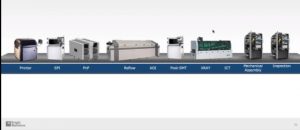EMS 2.0: What’s next for electronics manufacturing?
A typical electronics manufacturing assembly line generally consists of inspection, mechanical assembly, ICT, x-ray, post-SMT, automated optical inspection (AOI), reflow, PnP, solder paste inspection (SPI) and printer.
Today’s electronics product marketplace is somehow off-balance. Plant managers are feeling the pain. Key drivers of supply shortage include massive labor shortage and political instability. Key drivers of rising product demand include rise of the middle class, IoT and autonomous vehicles.
Bartosz Mazurek, VP Electronics Segment, Bright Machines, said that over 60 percent of plants are planning to focus on technology investments. They are looking to invest in workforce and acquire new technology. Automation in manufacturing is customized today. It drives cost, and is not completely flexible. There should be a much better way to manage the situation.
 Modular hardware way forward
Modular hardware way forward
A way forward is modular hardware. Bright Machines provides end-of-arm tools, such as grippers, screw driving, heat sink assembly, DIMM insertion, dispensing, soldering, labeling, functional testing, bar code reading, inspection, and tool changer. The feeding system consists of tray feeder and bowl feeder. The transport system comprises of an embedded conveyor, return conveyor and lift for conveyor. There are Bright robotic cells (BRCs) as well, such as BRC70 and BRC35.
Bright Machines has microfactories that are configured using modular hardware. The modular hardware approach is using Bright robotic cells. There is an intuitive programming and operation using the Brightware software. Brightware has integrated all of the elements. Next-gen automation is making the process very fast and does not require a highly-skilled expert. This enables you to get high-quality production, predictable production output, and provides an ability to scale.
Bright Machines highlighted two case studies. One, a heatsink assembly for telecom, where it provided a microfactory comprising one BRC and tray feeder. 33 percent more units were produced per hour, with 92 percent of fewer operations. Another, a case study of internal lighting and assembly for automotive. The solution was a microfactory, with four BRC and testing station.
Industry 4.0 all about digital transformation
Industry 4.0 is all about digital transformation. To enable this kind of a transformation, manufacturers have to improve their current automation capabilities. They need solutions that have to to be modular, flexible, re-usable and the time to deployment should be very short.
Data is becoming the currency of the future. Data should be collected in the cloud. Cloud-centric data enables real-time monitoring analytics. There should be configuration management, as well. This should be used across all deployments, moving forward. You also need robot teach, especially in the offline environment. The overall programming should happen in the offline environment.
You also need to do the overall programming in the offline digital twin environment, with real-physics simulation and remote deployment. Bright Machines helps customers transform their existing manufacturing process.












